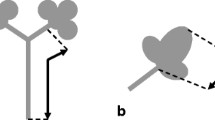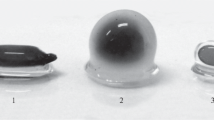Abstract
The bacterial microflora of nine varieties of witloof chicory (Cichorium intybus L. var.foliosum Hegi) seeds was studied. The 184 isolates were characterized by protein profiles determined by SDS-protein polyacrylamide gel electrophoresis of the total cell proteins. Isolates with identical protein profiles were grouped into one fingerprint type. Sixty-seven fingerprint types were distinguished. Two quantitatively major fingerprint types,Erwinia herbicola and an arthrobacter, represented 52% of the total number of isolates and were found on different chicory varieties. The latter organism was inhibited at seed germination. Other isolates, i.e.,Xanthomonas maltophilia, Pseudomonas paucimobilis, Agrobacterium radiobacter, Pseudomonas syringae, and a fluorescentPseudomonas, were only occasionally found. A minority were gram-positive isolates, i.e.,Bacillus sp.,Streptomyces sp., and coryneforms. In vitro activity of the isolates was tested against five fungi. Isolates with strong antifungal activity were found amongErwinia herbicola andBacillus sp.
Similar content being viewed by others
References
Aydin M, Lucht N, Konig WA, Lupp R, Jung G, Winkelmann G (1985) Structure elucidation of the peptide antibiotics Herbicolin A and B. Liebigs Ann Chem:2285–2300
Becker JO (1984) Isolation and characterization of antimycotic bacteria from rhizoisphere soil. In: Proc Brit Crop Protec Conf-Pests and Diseases, pp 365–369
Beer SV, Rundle JR (1980) Inhibition ofErwinia amylovora by bacteriocin-like substances. Phytopathology (Abstract) 70:459
Boylen CW (1973) Survival ofArthrobacter crystallopoietes during prolonged period of extreme desiccation. J Bacteriol 113:33–37
Chapman SJ, Gray TR (1981) Endogenous metabolism and macromolecular composition ofArthrobacter globiformis. Soil Biol Biochem 13:11–18
Chen M, Alexander M (1973) Survival of soil bacteria during prolonged desiccation. Soil Biol Biochem 5:213–221
Clement P (1987) Notes et etudes. Le commerce de l'endive dans le monde 1982–1987. MIFL 12:5–27
Fountain DW, Foard DE, Replogle WD, Yang WK (1977) Lectin release by soybean seeds. Science 197:1185–1187
Giha OH (1976) Natural wheat seed protection by saprophytic bacteria against infection byHelminthosporium rostratum. Plant Dis Rep 60:985–987
Hirano SS, Upper CD (1986) Temporal, spatial, and genetic variability of leaf-associated bacterial populations. In: Fokkema NJ, van den Heuvel J (eds) Microbiology of the phyllosphere. Cambridge University Press, Cambridge, pp 235–251
Hsieh SPY, Buddenhagen IW (1974) Suppressing effects ofErwinia herbicola on infection byXanthomonas oryzae and on symptom development in rice. Phytopathology 64:1182–1185
Hugh R, Leifson E (1953) The taxonomic signification of fermentative versus oxidative metabolism of carbohydrates by various gram-negative bacteria. J Bacteriol 66:24
Kersters K, De Ley J (1980) Classification and identification of bacteria by electrophoresis of their proteins. In: Goodfellow M, Board R (eds) Microbiological classification and identification. Soc Appl Bacteriol Series No 8. Academic Press, London, pp 273–297
King EO, Ward M, Raney DE (1954) Two simple media for the demonstration of pyocyanin and fluorescein. J Lab Clin Med 44:301–307
Kremer RJ (1987) Identity and properties of bacteria inhabiting seeds of selected broadleaf weed species. Microbial Ecol 14:29–37
Kremer RJ, Hughes LB Jr, Aldrich RJ (1984) Examination of micro-organisms and deterioration resistance mechanisms associated with velvetleaf seed. Agronomy J 76:745–749
Lambert B, Leyns F, Van Rooyen L, Gossele F, Papon Y, Swings J (1987) Rhizobacteria of maize and their antifungal activities. App Env Microbiol 59:1866–1871
Lang DS, Kommedahl T (1976) Factors affecting efficacy ofBacillus subtilis and other bacteria as corn treatments. Proc Am Phytopathol Soc (Abstract) 3:272
Leben C (1965) Epiphytic microorganisms in relation to plant disease. Ann Rev Phytopathol 3:209–230
Lindow SE (1986) Strategies and practice of biological control of ice nucleation-active bacteria on plants. In: Fokkema NJ, van den Heuvel J (eds) Microbiology of the phyllosphere. Cambridge University Press, Cambridge, pp 77–100
McFaddin JF (1981) Biochemical tests for identification of medical bacteria. Williams and Wilkins, Baltimore, pp 527
McGee DC (1981) Seed pathology: its place in modern seed production. Plant Dis 65:638–642
McGee DC, Brandt CL, Burris JS (1980) Seed mycoflora of soybeans relative to fungal interactions, seedling emergence, and carry-over of pathogens to subsequent crops. Phytopathology 70:615–617
Mishkind M, Raikhel NV, Palevitz BA, Keegstra K (1982) Immunocytochemical localization of wheat germ agglutinin in wheat. J Cell Biol 92:753–764
Mundt JO, Hinckle NF (1976) Bacteria within ovules and seeds. App Env Microbiol 32:694–698
Neergaard P (1977) Seed pathology. Vol 1 and 2. MacMillan, London
Palleroni NJ (1984)Pseudomonadaceae. In: Krieg NR, Holt JG (eds) Bergey's manual of systematic bacteriology. Williams and Wilkins, Baltimore, pp 141–199
Pistole TG (1981) Interactions of bacteria and fungi with lectins and lectin-like substances. Ann Rev Microbiol 35:85–112
Rudiger H (1984) On the physiological role of plant lectins. BioSci 34:95–98
Sauer DB, Burroughs R (1986) Disinfection of seed surfaces with sodium hypochlorite. Phytopathology 76:745–749
Schaeffer AB, Fulton M (1933) A simplified method of staining endospores. Science 77:194
Vantomme R, Vermeulen V, Swings J, De Ley J, Sarrazyn R (1985) Bakterierot op witloof tijdens de trek. Landbouwtijdschrift 38:473–480
Verona O (1959) La spermosphère. Ann Inst Pasteur 95:795–798
Winkelmann G, Gluck C (1981) Herbicolins—new peptide antibiotics from enterobacteria. In: Voelter W, Weitzel G (eds) Structure and activity of natural peptides. Walter de Gruyter, Berlin, pp 237–252
Author information
Authors and Affiliations
Rights and permissions
About this article
Cite this article
Van Outryve, M.F., Gosselé, V., Gosselé, F. et al. Composition of the microflora of witloof chicory seeds. Microb Ecol 16, 339–348 (1988). https://doi.org/10.1007/BF02011705
Issue Date:
DOI: https://doi.org/10.1007/BF02011705




